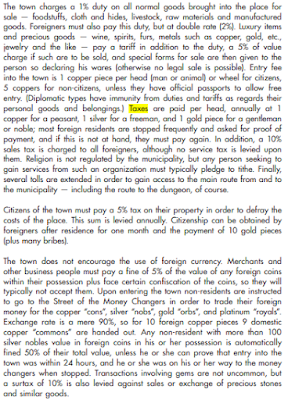Here's something that I mentioned very briefly in my post about the AD&D DMG's section on "taxes" (including duties, excises, fees, tariffs, tithes, and - most notably with regards to this post - tolls) and the indentured servitude of those who fail to pay - the local municipality maintains a road to "the dungeon":
We can interpret "the dungeon" in this case as referring to the single dungeon with which campaign play begins, as described in the opening to the section titled "THE CAMPAIGN":
This is not dissimilar to the guidance in the section titled "THE WILDERNESS" in OD&D's Book III: The Underworld and Wilderness:
While a dungeon can be very big (even infinite) and can sustain entire campaigns all on its own, we know from AD&D's Appendix B that if we zoom out to a large enough scale, we will surely find more than just a single dungeon in the area of play. My 100-hex sandbox, for example, has two:
Any given dungeon on the campaign map, however large or small, could be "the dungeon" in a campaign of its own. This is all to say, to use Gygax's phrasing, "of course" whichever municipality is closest to any given dungeon will maintain a road on the route to that dungeon!
Why is this noteworthy? Well, first of all, I find it interesting. My conception of the dungeon has always been that it is a desolate place. Sure, it isn't typically far from the player characters' "home base" because exploring the dungeon is the default mode of play in the early game, when the characters are low-level, and adventuring in the wilderness is dangerous business. Therefore, characters need to be able to travel to and from the dungeon swiftly, lest they get unlucky and run afoul of a dragon or a group of 40 bandits.
Even considering the likely proximity of the dungeon to a settlement, I certainly never considered that there would be a road leading straight to it. A trail, maybe, carved out as a desire path of sorts by the numerous adventures who have traveled there to make their fortune in the past, but a proper road? Like a good enough one that the municipality charges a toll to use it? Why would this be?
Well, it's income. Considering the likely proximity to the settlement, one can imagine that it isn't particularly expensive to maintain such a road. Given that exploring the dungeon is the entry level job of the adventuring career path, and that seemingly anyone who wants to be anyone in a D&D society must obtain and wield power through adventuring and the accumulation of levels (D&D is a levelocracy), there are probably a lot of people - a lot of eventually wealthy people - who will want to use that road. Since common peasants probably aren't going there, the municipality can even charge a much heftier toll on that road in particular. It pays for itself and then some.
Don't forget to charge the player characters not just per head but per wheel ("and possibly even materials transported"):
If the characters are bringing carts and wagons to haul their treasure, and depending on what sorts of materials are tolled, this could add up fast!
This also allows the municipality to maintain some level of control over the dungeon and those who wish to visit it. The local government of the town or city could certainly send some 0th-level men to explore the dungeon and plunder its riches to line the ruler's pockets - a big enough settlement almost certainly has more resources than a handful of 1st-level player characters - but why bother doing so, when they can simply charge adventurers a fee to exploit the dungeon for them, then exploit those same adventurers in turn?
The local ruler can thus monitor who is making forays into the dungeon, which allows them to keep track of those adventurers who might prove to be of greater usefulness - or might one day grow to be greater threats. It also might ensure that player characters are on their best behavior in the settlement itself - if they cause enough trouble or get on the ruler's bad side, they might find themselves turned away at the toll station on their next expedition.
This also allows the Dungeon Master to provide local color to the region depending on the ruler's nature. The dungeon is, after all, within the ruler's domain, and Lawful, Chaotic, Good, and Evil rulers will assert their dominion over it to varying degrees and using different means. A benevolent ruler may charge no toll at all to those known to be do-gooders, while a malicious one may impose even greater tolls, require generous bribes in exchange for documentation granting access, or heavily tax or even unjustly confiscate any goods hauled from within at their whim.
Much like with the other forms of taxation Gygax describes, the fees, surveillance, and politics are sure to annoy players. What will they do when it all becomes too much to bear? Well, they'll go offroad, into the wilderness, to carve their own path to the site of adventure - one that isn't subject to the local powers that be. When doing so, they must not only brave the aforementioned dangers of the wilderness, but the danger of being caught - confiscation of all goods, a fine, and possible imprisonment:
This is, once again, a great way for player characters to become indentured to the city watch! Or worse. The Chaotic Evil warlord who rules the nearby town isn't likely to take kindly to this trespass, after all.






















